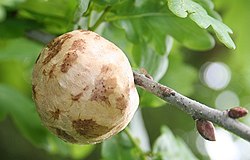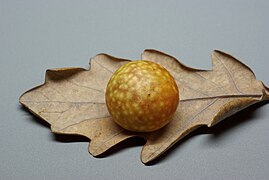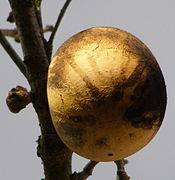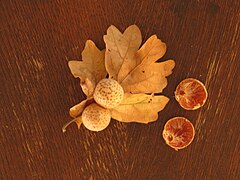Oak apple
This article needs additional citations for verification. (May 2023) |



Oak apple or oak gall is the common name for a large, round, vaguely apple-like
Formation
The adult female wasp lays single eggs in developing leaf buds. The wasp larvae feed on the gall tissue resulting from their secretions, which modify the oak bud into the gall, a structure that protects the developing larvae until they undergo metamorphosis into adults.
Some common oak-apple-forming species are the Biorhiza pallida gall wasp in Europe, Amphibolips confluenta in eastern North America, and Atrusca bella in western North America.[1] Oak apples may be brownish, yellowish, greenish, pinkish, or reddish.
Other galls
Considerable confusion exists in the general literature between the oak apple and the oak marble gall. The oak marble is frequently called the oak apple due to the superficial resemblance and the preponderance of the oak marble gall in the wild. Other galls found on oak trees include the oak artichoke gall and the acorn cup gall, but each of these has its own distinctive form.
Iron gall ink
Oak galls have been used in the production of ink since at least the time of the Roman Empire. From the Middle Ages to the early twentieth century, iron gall ink was the main medium used for writing in the Western world.[2]
Gall nuts are a source of tannin in the production of iron gall ink. Tannins belong to a group of molecules known as polyphenols and can be taken from different parts of plants such as leaves, pods, fruits, and gall nuts.
Along with gall nuts, other important ingredients in the production of iron gall ink include iron sulfate and gum arabic. The reaction between the tannins from the gall nut and the iron produces a complex that gives the iron gall ink its color. The gum arabic makes the ink more viscous and helps bind the ink to the writing surface.[3]
Folklore
It is said that if a "worm" is found inside the gall on
Gallery
-
An oak apple on an oak leaf.
-
Oak apples
-
An oak tree with multiple oak apples.
-
Andricus kollari oak gall
-
Oak apples on an oak tree.
-
Oak apple gall on Garry oak (Quercus garryana)
-
Oak apples on oak leaf and in cross section
-
Biorhiza pallida male
List of galls called oak apples
| Image | Binomial name | Host species | Region |
|---|---|---|---|

|
Andricus quercuscalifornicus[5] | valley oak, California scrub oak | North America |
| Atrusca bella[5] | Arizona white oak, Mexican blue oak, netleaf oak, Toumey oak, and shrub live oak | North America | |

|
Atrusca brevipennata[5] | shrub live oak, Gambel oak
|
North America |
 |
Atrusca capronae[5] | shrub live oak | North America |

|
Besbicus mirabilis[5] | Oregon oak | North America |
 |
Trichoteras coquilletti[5] | canyon live oak |
North America |
 |
Trichoteras vacciniifoliae[5] | Huckleberry oak, canyon live oak | North America |
See also
- Knopper gall
- Pineapple gall
References
- ^ ISBN 0-691-09560-4.
- ^ Diringer, David (1 March 1982). The Book Before Printing: Ancient, Medieval and Oriental. Dover Publications. pp. 551–2.
- ^ "Iron Gall Ink". travelingscriptorium.library.yale.edu. 21 March 2013. Retrieved 24 May 2023.
- ^ Roud, Steven (2003). The Penguin Guide to the Superstitions of Britain and Ireland. Penguin Books. p. 344.
- ^ LCCN 2020949502.








